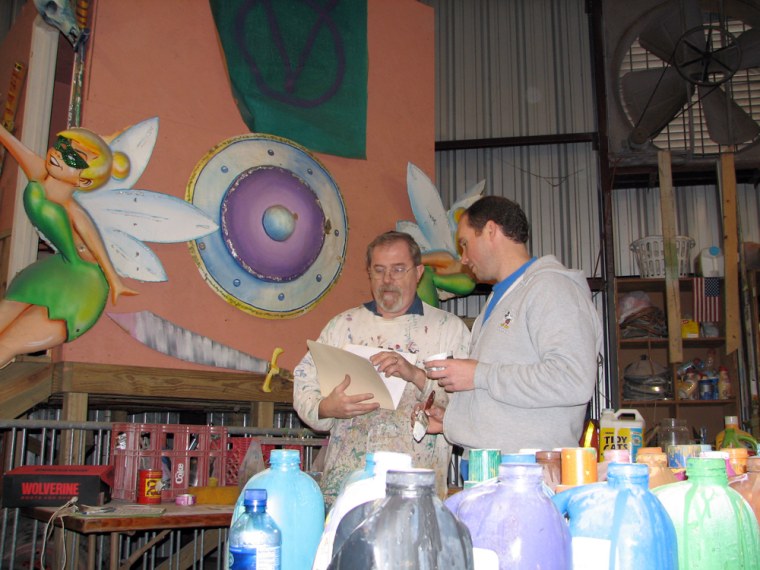Mobile's Mardi Gras parades couldn't be staged without float builders like Stephen Mussell, who has built a career on the carnival's demand for rolling showpieces of splashy colors and lights.
His year-round work was seen by an apparent record number of Mobile Mardi Gras revelers last year, an uptick attributed partly to Hurricane Katrina. The port city, with more than 30 parades over the weeks culminating on Fat Tuesday, may benefit again this year as coastal Mississippi's festivities in Biloxi will remain cut back to one parade due to Katrina damage.
New Orleans, which has long enjoyed the nation's largest carnival, is also trying to revive its celebration and expects a parade schedule comparable to pre-Katrina levels.
Whatever the numbers, Mussell's 10-member team is turning the floats - most averaging 35 feet in length - into pastel perches for the Mardi Gras organizations, known as krewes, whose members ride them and throw heaps of trinkets, candy, beads, Moon Pies and stuffed animals to thousands lining the streets for two weeks of parading.
Major parades begin Feb. 2 and run through Mardi Gras Day, Feb. 20, giving businesses an economic bonanza. Many reap an entire year's profit during carnival - if the weather is good.
Mobile has about a half-dozen float builders and designers like Mussell whose teams twist chicken wire into dragons, tigers, goofy characters and scenery. Each float has a light-hearted theme.
"To do five parades takes all year," Mussell said, wearing a paint-splattered sweatshirt while putting the decorative touches on 11 floats parked in a huge warehouse near Mobile's waterfront.
Mussell, who has been building floats for 29 years, buys gallons of latex house paint, then tints it to "kick it up" before it's sprayed on. The electrical lighting comes last and is needed because some parades roll at night.
His 22-year-old son, Nathan Mussell, is part of the team. With a history degree from Auburn University, the younger Mussell leaves in June for the Peace Corps. But when he's home, he's float-building, a family obsession.
"I was born on Mardi Gras Day in 1984," he said.
High school French teacher Will Edmond has worked part-time with Mussell on the floats during holidays and school breaks for the last eight years.
"It's unique, that's for sure," said Edmond, 33, who says his family has attended Mardi Gras events for 30 years - standing at the same spot to view parades.
Another Mussell worker, 17-year-old Greg Thornton, said he works on the Mardi Gras floats "so I can be around it all year long."
After Hurricane Katrina struck in 2005, Mobile advertised its "family-oriented" carnival in markets within a 150-to-200-mile radius, including Jackson, Miss., Hattiesburg, Miss., Baton Rouge, La., Birmingham and Montgomery, to counter reports about damages. Mobile was largely unscathed by Katrina.
Leon Maisel, president and CEO of the Mobile Bay Convention & Visitors Bureau, said police estimated more than 1 million attended carnival here in 2006, an apparent record attributed to the Katrina damage to the Mississippi coast and New Orleans.
The ad campaign has shifted to the city's conventions, but Maisel said he hopes many of those visitors will return in February.
Neighboring Biloxi, Miss., will have only one parade on the afternoon of Feb. 20, said Nancy Rogers, a spokeswoman for the Gulf Coast Carnival Association. Biloxi trimmed its parade schedule last year to one 2-hour parade because of Katrina damage. The U.S. Highway 90 bridge between Biloxi and Ocean Springs, damaged by the storm, still hasn't been repaired, so this year's plans weren't increased, Rogers said.
New Orleans, devastated by winds and flooding when Katrina struck on Aug. 29, 2005, has an Alabama connection to its carnival this year: American Idol winner Taylor Hicks of Birmingham will reign as the Krewe of Endymion's grand marshal. Endymion will roll down historic St. Charles Avenue on Feb. 17, the Saturday before Fat Tuesday.
New Orleans' officials are hopeful attendance will be strong.
"A number of factors, including weather, affect overall attendance, but we are hopeful that with the hotel room inventory continuing to come back and other tourism-related infrastructure in place, we will have strong visitation for Mardi Gras," marketing director Ernest Collins said in a statement.
The city has about 30,000 of its 38,000 hotel rooms back in service.
Collins said attendance was "surprisingly strong last year given the inclement weather and the status of our recovery. With the absence of controversy regarding the appropriateness of the celebration, we expect that we'll have incremental improvement on attendance from 2006 to 2007."
Historians say the carnival was born in Mobile among the French colonists in the 1700s, but it didn't really catch on until 1830, when a group of rowdies hit the streets with cowbells and rakes taken from a hardware store. They called themselves the Cowbellion de Rakin Society.
